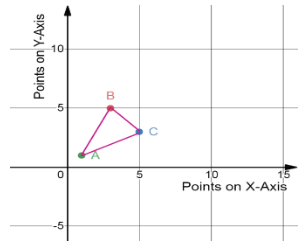
On squared paper draw the triangle with vertices at (1,1), (5,3), (3,5). Find the area of the triangle.
Answer
573.3k+ views
Hint: For this question, we need to draw the given points of vertices of a triangle and find out the area of the triangle. Use the formula of the area of a triangle as given below.
Formula used: Area of Triangle $ = \dfrac{1}{2}\left| {\left. {\left( {\begin{array}{*{20}{c}}
{({x_1} - {x_2}}&{{x_1} - {x_3}} \\
{{y_1} - {y_2}}&{{y_1} - {y_3}}
\end{array}} \right)} \right|} \right|$ --(1)
where, these vertical lines in equation 1 will represent determinants, and $({x_1},{y_1})$,\[({x_2},{y_2})\],$({x_3},{y_3})$ will represent the coordinates for the vertices of a triangle and more specifically ${x_1},{x_2},{x_3}$ be the x-axis coordinates and ${y_1},{y_2},{y_3}$be the y-axis coordinates.
Now to solve the determinants please use the concept given by equation (2)
\[ = \;\;\left| {\left( {\begin{array}{*{20}{c}}
a&b \\
c&d
\end{array}} \right)} \right| = ad - bc\] --(2)
A solution of equation 2 we will get by simple cross-multiplication of opposite diagonal elements and separate them with a negative sign.
Complete step-by-step answer:
(Step 1) Here we will write down the given coordinates and assign it as A=$(1,1), $B=$(3,5), $C= $(5,3)$
(Step 2) Now we will simply plot the coordinates on the x and y-axis with.

(Step 3) Now simply substitute all the points A, B, and C in equation 1, as discussed in the hint section above.
$ \Rightarrow Area = \dfrac{1}{2}\left| {\left( {\begin{array}{*{20}{c}}
{(1 - 5)}&{(1 - 3)} \\
{(1 - 3)}&{(1 - 5)}
\end{array}} \right)} \right|$
(Step 4) Solve the given question with valid points.
$ \Rightarrow Area = \dfrac{1}{2}\left| {\left( {\begin{array}{*{20}{c}}
{ - 4}&{ - 2} \\
{ - 2}&{ - 4}
\end{array}} \right)} \right|$
$ \Rightarrow Area = \dfrac{1}{2}\left| {( - 4)( - 4) - ( - 2)( - 2)} \right|$
$
\Rightarrow Area = \dfrac{1}{2}\left| {16 - 4} \right| \\
\Rightarrow Area = \dfrac{1}{2}\left| {12} \right| \\
\therefore Area = 6unit{s^2} \\
$
The area of a triangle found from the given coordinates of vertices is \[6\]${(units)^2}$. Remember area is measured in square units but as no dimensions, for now, is mentioned in the question so we have simply represented it as $unit{s^2}$.
Area of the triangle is \[6\]${(units)^2}$
Note: Another approach to solving this question is to make use of the graphical analysis as done on the plotted figure above. Area of any quantity cannot be negative.
Formula used: Area of Triangle $ = \dfrac{1}{2}\left| {\left. {\left( {\begin{array}{*{20}{c}}
{({x_1} - {x_2}}&{{x_1} - {x_3}} \\
{{y_1} - {y_2}}&{{y_1} - {y_3}}
\end{array}} \right)} \right|} \right|$ --(1)
where, these vertical lines in equation 1 will represent determinants, and $({x_1},{y_1})$,\[({x_2},{y_2})\],$({x_3},{y_3})$ will represent the coordinates for the vertices of a triangle and more specifically ${x_1},{x_2},{x_3}$ be the x-axis coordinates and ${y_1},{y_2},{y_3}$be the y-axis coordinates.
Now to solve the determinants please use the concept given by equation (2)
\[ = \;\;\left| {\left( {\begin{array}{*{20}{c}}
a&b \\
c&d
\end{array}} \right)} \right| = ad - bc\] --(2)
A solution of equation 2 we will get by simple cross-multiplication of opposite diagonal elements and separate them with a negative sign.
Complete step-by-step answer:
(Step 1) Here we will write down the given coordinates and assign it as A=$(1,1), $B=$(3,5), $C= $(5,3)$
(Step 2) Now we will simply plot the coordinates on the x and y-axis with.

(Step 3) Now simply substitute all the points A, B, and C in equation 1, as discussed in the hint section above.
$ \Rightarrow Area = \dfrac{1}{2}\left| {\left( {\begin{array}{*{20}{c}}
{(1 - 5)}&{(1 - 3)} \\
{(1 - 3)}&{(1 - 5)}
\end{array}} \right)} \right|$
(Step 4) Solve the given question with valid points.
$ \Rightarrow Area = \dfrac{1}{2}\left| {\left( {\begin{array}{*{20}{c}}
{ - 4}&{ - 2} \\
{ - 2}&{ - 4}
\end{array}} \right)} \right|$
$ \Rightarrow Area = \dfrac{1}{2}\left| {( - 4)( - 4) - ( - 2)( - 2)} \right|$
$
\Rightarrow Area = \dfrac{1}{2}\left| {16 - 4} \right| \\
\Rightarrow Area = \dfrac{1}{2}\left| {12} \right| \\
\therefore Area = 6unit{s^2} \\
$
The area of a triangle found from the given coordinates of vertices is \[6\]${(units)^2}$. Remember area is measured in square units but as no dimensions, for now, is mentioned in the question so we have simply represented it as $unit{s^2}$.
Area of the triangle is \[6\]${(units)^2}$
Note: Another approach to solving this question is to make use of the graphical analysis as done on the plotted figure above. Area of any quantity cannot be negative.
Recently Updated Pages
Master Class 8 Social Science: Engaging Questions & Answers for Success

Master Class 8 Maths: Engaging Questions & Answers for Success

Master Class 8 Science: Engaging Questions & Answers for Success

Class 8 Question and Answer - Your Ultimate Solutions Guide

Master Class 8 English: Engaging Questions & Answers for Success

Why are manures considered better than fertilizers class 11 biology CBSE

Trending doubts
Which one of the following groups comprises states class 8 social science CBSE

Full form of STD, ISD and PCO

A couple went for a picnic They have 5 sons and each class 8 maths CBSE

What is the difference between rai and mustard see class 8 biology CBSE

Advantages and disadvantages of science

Differentiate between the farms in India and the U class 8 social science CBSE




